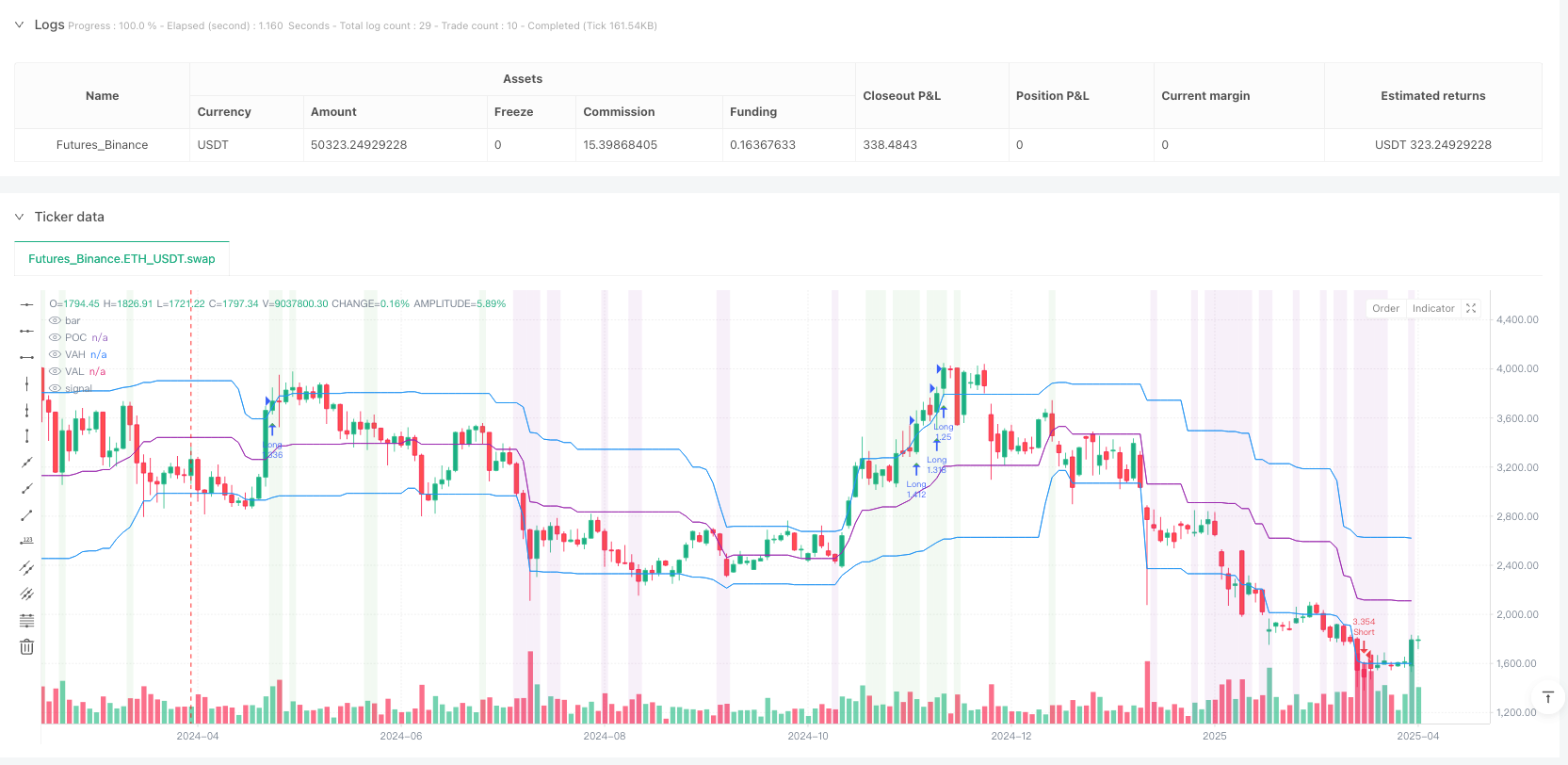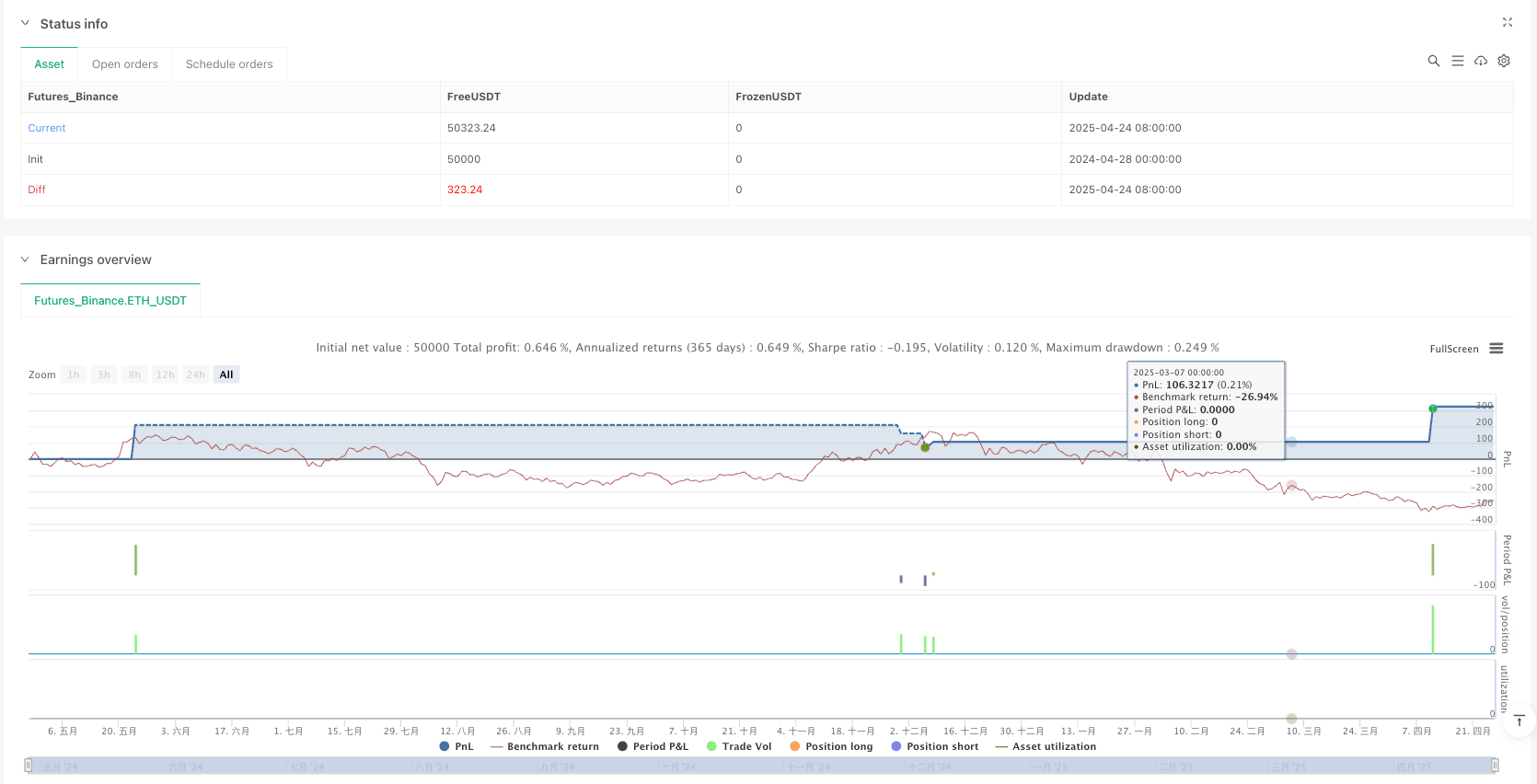多周期均值回归趋势突破交易系统
EMA RSI ATR MACD MFI VAH VAL POC Wyckoff MEAN REVERSION TREND FOLLOWING Swing Trading

策略概述
多周期均值回归趋势突破交易系统是一个综合性的量化交易策略,它巧妙地融合了威科夫市场周期理论、价格图谱分析、均值回归和趋势跟踪四种强大的交易方法。该策略专为中长期摇摆交易者设计,提供了广泛的自定义选项,使交易者能够根据自己的风险偏好和市场状况进行灵活调整。
策略核心组件包括威科夫分析以识别市场周期阶段,价格图谱分析以确定关键支撑和阻力位,均值回归组件用于识别过度买入或卖出情况,以及趋势跟踪系统用于捕捉中长期价格走势。这些组件共同工作,形成一个全面的交易系统,旨在提供高概率的交易信号。
策略原理
该策略的核心原理基于四个主要交易方法的协同作用:
威科夫分析:该组件根据理查德·D·威科夫的市场周期理论识别四个主要阶段 - 积累阶段、上升阶段、分配阶段和下降阶段。策略还检测特殊形态如”弹簧”模式(假突破后的快速反转)和”上推”模式(假突破)。这些阶段通过价格和成交量的关系进行定义,帮助交易者跟随机构资金流向。
价格图谱分析:该组件实现了市场剖面/成交量剖面的简化版本,计算控制点(POC)、价值区域高点(VAH)和价值区域低点(VAL),以建立主要价格活动发生的范围。这些关键水平的可视化表示有助于识别潜在的支撑和阻力区域。
均值回归:当价格移动到极端区域时,该组件识别潜在的反转点。它使用布林带定义超买和超卖价格区域,并结合RSI背离来确认潜在反转。为避免在强趋势中的虚假信号,该策略要求多重确认信号。
趋势跟踪:该组件捕捉中长期方向性价格走势,利用多个移动平均线(9、21、50、200 EMA)确认趋势方向和强度,MACD分析用于动量确认和趋势强度,以及通过最近价格结构分析实现高时间框架趋势一致性。
这四个组件相互补充,共同作用于产生交易信号。系统使用了复杂的信号组合方法,要求多个系统确认才能生成最终交易信号,有效降低了虚假信号的可能性。
策略优势
多周期均值回归趋势突破交易系统具有以下显著优势:
综合性分析框架:通过整合四种不同但互补的交易方法,该策略能够从多个角度分析市场,提高交易信号的质量和可靠性。这种多维分析减少了单一指标可能带来的偏差和错误信号。
适应不同市场条件:策略的灵活性使其能够在不同的市场环境中表现良好。在趋势市场中,趋势跟踪组件占主导地位;在区间震荡市场中,均值回归和价格图谱分析更有效。
机构资金流向对齐:通过威科夫分析,策略旨在与机构资金流向保持一致,这对于长期成功交易至关重要。该组件帮助交易者识别大资金的积累和分配阶段,提高交易的成功率。
强大的风险管理:策略内置了多种风险管理功能,包括基于ATR的自动止盈止损、尾随止损、基于持仓时间的退出策略,以及基于权益百分比的头寸规模计算。这些功能共同确保了资金管理的稳健性。
高度可定制:策略提供了广泛的参数设置,使交易者能够根据自己的交易风格、市场偏好和风险承受能力进行调整。主要组件可以独立启用或禁用,使策略能够适应不同的交易方法。
策略风险
尽管该策略具有众多优势,但也存在以下潜在风险和挑战:
参数过度优化风险:策略包含大量可调参数,这可能导致过度拟合历史数据的风险。交易者应注意避免过度优化,并在实际交易前进行稳健的前向测试。
复杂性管理:策略的综合性也带来了复杂性。理解和管理所有组件的相互作用可能具有挑战性,特别是对于新手交易者。建议先理解每个独立组件,然后逐步整合使用。
市场条件变化:某些市场条件下,特定组件可能表现不佳。例如,在快速趋势转变期间,均值回归信号可能产生亏损。交易者需要监控市场环境,并相应调整策略组件的权重。
执行延迟影响:策略的多重确认要求可能导致入场点延迟,尤其是在快速波动的市场中。这可能导致部分趋势被错过或在次优价格进入市场。
技术指标依赖:策略严重依赖技术指标,如移动平均线、RSI和MACD。在某些市场条件下,这些指标可能失效或产生误导性信号。建议结合基本面分析或其他非技术性因素作为补充。
减轻这些风险的方法包括:逐步实施策略,从小仓位开始;定期回测和优化;使用样本外测试验证策略有效性;以及设置严格的风险管理规则,如每笔交易和每日最大损失限制。
策略优化方向
基于对代码的深入分析,该策略可以在以下几个方向进行优化:
自适应参数设置:当前策略使用固定参数值,如RSI周期和布林带标准差。可以通过实现基于波动性或市场状态的自适应参数,提高策略在不同市场环境中的表现。例如,在高波动性市场中使用较宽的布林带,在低波动性市场中使用较窄的布林带。
机器学习集成:通过引入机器学习算法来优化信号生成和过滤过程。例如,可以使用分类算法预测信号的成功概率,或使用强化学习寻找最佳参数组合。这将使策略能够不断适应和学习新的市场模式。
增强的时间框架分析:当前策略主要在单一时间框架上运行。通过添加真正的多时间框架分析功能,可以提高信号质量。例如,只有当日线、周线和月线趋势方向一致时才进行交易,从而减少逆势交易的风险。
改进的威科夫识别算法:当前的威科夫相位识别相对简单。可以开发更复杂的算法来准确识别威科夫积累和分配模式,如使用成交量分布、成交量加权平均价格和相对强度指标的组合。
多品种相关性分析:通过添加多品种相关性分析,策略可以考虑相关市场的动态。例如,在商品交易中考虑美元指数的走势,或在股票交易中考虑行业指数的表现。这将提供更全面的市场视角。
优化退出策略:当前的退出机制主要基于时间和RSI。可以通过实现更复杂的退出策略来提高盈利能力,如基于动态支撑/阻力水平的部分利润获取,或使用波动性收缩模式作为退出触发器。
增强风险管理:添加更复杂的风险管理功能,如基于回撤的头寸调整,相关性加权的投资组合管理,以及考虑市场流动性和滑点的订单执行逻辑。
总结
多周期均值回归趋势突破交易系统是一个全面、灵活的量化交易策略,适合中长期摇摆交易者使用。它的核心优势在于融合了多种互补的交易方法,提供了稳健的信号生成机制和广泛的风险管理功能。
该策略通过整合威科夫市场周期理论、价格图谱分析、均值回归和趋势跟踪,创建了一个能够适应各种市场条件的交易系统。它的设计旨在与机构资金流向保持一致,通过要求多重确认来减少虚假信号,并提供灵活的出入场机制来优化交易结果。
尽管存在参数优化、复杂性管理和市场条件变化等挑战,但通过谨慎实施和持续优化,该策略可以成为交易者工具箱中的有力武器。通过引入自适应参数、机器学习技术、增强的多时间框架分析和改进的退出策略,该系统有潜力在未来进一步提高其性能和适应性。
对于寻求稳健、系统化交易方法的交易者而言,多周期均值回归趋势突破交易系统提供了一个坚实的基础,可以基于个人偏好和市场经验进行定制和扩展。
/*backtest
start: 2024-04-28 00:00:00
end: 2025-04-26 08:00:00
period: 2d
basePeriod: 2d
exchanges: [{"eid":"Futures_Binance","currency":"ETH_USDT"}]
*/
//@version=5
strategy("Wyckoff Advanced Swing Strategy by TIAMATCRYPTO", overlay=true, default_qty_type=strategy.percent_of_equity, default_qty_value=10)
// Main strategy settings
enableWyckoff = input.bool(true, "Enable Wyckoff")
enablePriceMap = input.bool(true, "Enable Price Map Profile")
enableMeanReversion = input.bool(true, "Enable Mean Reversion")
enableTrendFollowing = input.bool(true, "Enable Trend Following")
// TP/SL settings
useAutoTPSL = input.bool(true, "Use Auto TP/SL")
profitFactor = input.float(2.5, "Profit Factor (ATR multiple)")
stopLossFactor = input.float(1.5, "Stop Loss Factor (ATR multiple)")
// Swing Trading Parameters
minHoldingDays = input.int(3, "Minimum Holding Period (days)")
maxHoldingDays = input.int(20, "Maximum Holding Period (days)")
useWeekdayFilter = input.bool(true, "Filter Trading Days")
useTrailingStop = input.bool(true, "Use Trailing Stop")
trailingStopAtrMult = input.float(2.0, "Trailing Stop (ATR multiple)")
// Alternative Exit Rules
useExitByRSI = input.bool(true, "Exit by RSI")
exitLongRSI = input.int(70, "Exit Long when RSI")
exitShortRSI = input.int(30, "Exit Short when RSI")
// General Parameters
atrPeriod = input.int(14, "ATR Period")
rsiPeriod = input.int(14, "RSI Period")
volPeriod = input.int(20, "Volume MA Period")
emaFastPeriod = input.int(9, "EMA Fast Period")
emaSlowPeriod = input.int(21, "EMA Slow Period")
emaMediumPeriod = input.int(50, "EMA Medium Period")
emaLongPeriod = input.int(200, "EMA Long Period")
// Indicators
atr = ta.atr(atrPeriod)
rsi = ta.rsi(close, rsiPeriod)
volMA = ta.sma(volume, volPeriod)
emaFast = ta.ema(close, emaFastPeriod)
emaSlow = ta.ema(close, emaSlowPeriod)
emaMedium = ta.ema(close, emaMediumPeriod)
emaLong = ta.ema(close, emaLongPeriod)
macd = ta.ema(close, 12) - ta.ema(close, 26)
macdSignal = ta.ema(macd, 9)
// Weekday Filters (1 = Monday, 5 = Friday)
isGoodEntryDay = useWeekdayFilter ? (dayofweek != 5 and dayofweek != 1) : true // Not on Monday and Friday
isGoodExitDay = useWeekdayFilter ? (dayofweek != 1 and dayofweek != 5) : true // Not on Monday and Friday
// ===================== Wyckoff Method =====================
accumulationPhase = false
markupPhase = false
distributionPhase = false
markdownPhase = false
spring = false
if enableWyckoff
// Define support and resistance
support = ta.lowest(low, 10)
resistance = ta.highest(high, 10)
// Detect Spring (fake downward breakout)
spring := low[1] < support[2] and close > support[1]
// Detect Upthrust (fake upward breakout)
upthrust = high[1] > resistance[2] and close < resistance[1]
// Wyckoff Market Phases
accumulationPhase := volume > volMA and rsi < 40 and ta.falling(high, 5) and close > open
markupPhase := emaFast > emaSlow and emaSlow > emaMedium and volume > volMA and rsi > 50
distributionPhase := volume > volMA and rsi > 60 and ta.rising(low, 5) and close < open
markdownPhase := emaFast < emaSlow and emaSlow < emaMedium and volume > volMA and rsi < 50
// ===================== Price Map Profile =====================
lookbackPeriod = 30
highestPrice = ta.highest(high, lookbackPeriod)
lowestPrice = ta.lowest(low, lookbackPeriod)
valueAreaHigh = highestPrice - (highestPrice - lowestPrice) * 0.15
valueAreaLow = lowestPrice + (highestPrice - lowestPrice) * 0.15
pointOfControl = (valueAreaHigh + valueAreaLow) / 2
// Plot Price Map Profile
plot(enablePriceMap ? pointOfControl : na, "POC", color.purple, 1)
plot(enablePriceMap ? valueAreaHigh : na, "VAH", color.blue, 1)
plot(enablePriceMap ? valueAreaLow : na, "VAL", color.blue, 1)
// ===================== Mean Reversion =====================
meanReversionBuy = false
meanReversionSell = false
if enableMeanReversion
// Optimized Bollinger Bands for swing trading
basisBB = ta.sma(close, 20)
devBB = ta.stdev(close, 20) * 2
upperBB = basisBB + devBB
lowerBB = basisBB - devBB
// Enhanced Mean Reversion Conditions
lowerBBHit = ta.crossunder(close, lowerBB) or (close < lowerBB and close[1] < lowerBB)
upperBBHit = ta.crossover(close, upperBB) or (close > upperBB and close[1] > upperBB)
// RSI divergence for better timing
rsiLow = ta.lowest(rsi, 5)
priceLow = ta.lowest(low, 5)
rsiHigh = ta.highest(rsi, 5)
priceHigh = ta.highest(high, 5)
bullishDivergence = low < priceLow and rsi > rsiLow
bearishDivergence = high > priceHigh and rsi < rsiHigh
// Mean Reversion Swing Trading Signals
meanReversionBuy := lowerBBHit and rsi < 30 and bullishDivergence
meanReversionSell := upperBBHit and rsi > 70 and bearishDivergence
// ===================== Trend Following =====================
trendFollowingBuy = false
trendFollowingSell = false
if enableTrendFollowing
// Strong Trend Conditions
strongUptrend = emaFast > emaSlow and emaSlow > emaMedium and emaMedium > emaLong
strongDowntrend = emaFast < emaSlow and emaSlow < emaMedium and emaMedium < emaLong
// Simulated multi-day trend confirmation
recentHigherHigh = high > ta.highest(high[1], 5)
recentLowerLow = low < ta.lowest(low[1], 5)
// MACD Filters
macdRising = macd > macd[1] and macd[1] > macd[2]
macdFalling = macd < macd[1] and macd[1] < macd[2]
// Stronger Filters for Swing Trading
trendFollowingBuy := strongUptrend and macd > macdSignal and macdRising and recentHigherHigh
trendFollowingSell := strongDowntrend and macd < macdSignal and macdFalling and recentLowerLow
// ===================== Combine Signals =====================
wyckoffBuy = enableWyckoff and spring and accumulationPhase
wyckoffSell = enableWyckoff and distributionPhase
mrBuy = enableMeanReversion and meanReversionBuy
mrSell = enableMeanReversion and meanReversionSell
tfBuy = enableTrendFollowing and trendFollowingBuy
tfSell = enableTrendFollowing and trendFollowingSell
// Combine all strategies
buySignal = (wyckoffBuy or mrBuy or tfBuy) and isGoodEntryDay
sellSignal = (wyckoffSell or mrSell or tfSell) and isGoodEntryDay
// Add Candle Confirmation for better entries - full candle above/below EMA
buyConfirmation = close > open and close > emaMedium
sellConfirmation = close < open and close < emaMedium
// Track holding days
var int daysInTrade = 0
daysInTrade := strategy.position_size != 0 ? daysInTrade + 1 : 0
// Time-Based Exit
exitLongByTime = strategy.position_size > 0 and (daysInTrade >= maxHoldingDays or (daysInTrade >= minHoldingDays and isGoodExitDay))
exitShortByTime = strategy.position_size < 0 and (daysInTrade >= maxHoldingDays or (daysInTrade >= minHoldingDays and isGoodExitDay))
// Exit by RSI
exitLongByRSI = useExitByRSI and strategy.position_size > 0 and rsi >= exitLongRSI and daysInTrade >= minHoldingDays
exitShortByRSI = useExitByRSI and strategy.position_size < 0 and rsi <= exitShortRSI and daysInTrade >= minHoldingDays
// Trading logic - Swing Trading adjusted with TP/SL optional
if buySignal and buyConfirmation and strategy.position_size <= 0
strategy.cancel_all()
strategy.entry("Long", strategy.long)
if useAutoTPSL
strategy.exit("TP/SL Long", "Long", profit = atr * profitFactor, loss = atr * stopLossFactor)
if sellSignal and sellConfirmation and strategy.position_size >= 0
strategy.cancel_all()
strategy.entry("Short", strategy.short)
if useAutoTPSL
strategy.exit("TP/SL Short", "Short", profit = atr * profitFactor, loss = atr * stopLossFactor)
// Trailing Stop if enabled and no fixed TP/SL
if useTrailingStop and not useAutoTPSL and strategy.position_size != 0
longTrailPrice = high - atr * trailingStopAtrMult
shortTrailPrice = low + atr * trailingStopAtrMult
if strategy.position_size > 0
strategy.exit("Trailing Stop Long", "Long", trail_price=longTrailPrice)
else if strategy.position_size < 0
strategy.exit("Trailing Stop Short", "Short", trail_price=shortTrailPrice)